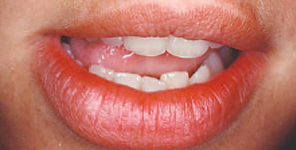Speech Misarticulations

When the tongue stays low in the mandible, at rest, and thrusts during swallow and the nasal breathing is not optimal, then speech mis-articulations, often called lisps, develop or persist. The sound /s/ is produced like a /th/, with the tongue between teeth, which is incorrect in English language. Other problems are an excessive protrusion of the tongue for /L/, /th/, lateral lisp for /s/ and /z/, insufficient or delayed development of /r/.
OMT
HELPS

Speech pathologists are able to identify the origin of the misarticulations: anatomical (tongue tie), physiological (lack of proper nasal breathing or neurological (dyspraxia/apraxia) and provide adequate treatment. Other professionals can optimize oral functions or eliminate dysfunctions that accompany misarticulations.
IF NOT
TREATED

The speech misarticulations are more a social issue and a symptom of more significant orofacial dysfunctions, such as ineffective nasal breathing, tongue thrust, open mouth posture etc. Ignoring the underlining causes of orofacial dysfunctions that present themselves with lisps may contribute to changes in craniofacial growth and development, malocclusion and more.

12. Speech Misarticulations
–Marchesan IQ1, Berretin-Félix G, Genaro KF. MBGR protocol of orofacial myofunctional evaluation with scores. Int J Orofacial Myology. 2012 Nov;38:38-77.
–Khinda V, Grewal N. Relationship of tongue-thrust swallowing and anterior open bite with articulation disorders: a clinical study. J Indian Soc Pedod Prev Dent. 1999 Jun;17(2):33-9.
–Dworkin JP, Culatta RA. Tongue strength: Its relationship to tongue thrusting, openbite, and articulatory pro ciency. Journal of Speech and Hearing Disorders. 1980. 45, 277-282.
–Fletcher, SG, Casteel RL, & Bradley DP. Tongue thrust swallow, speech articulation, and age. Journal of Speech and Hearing Disorders. 1961. 26, 219.